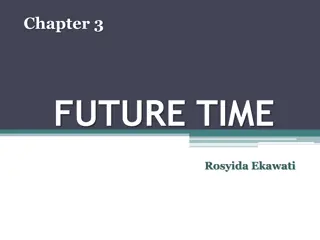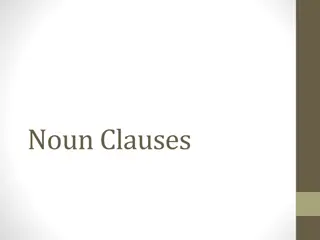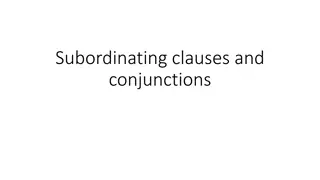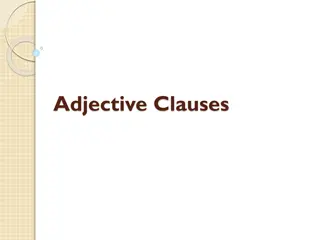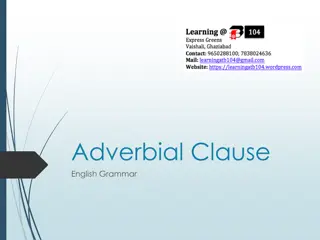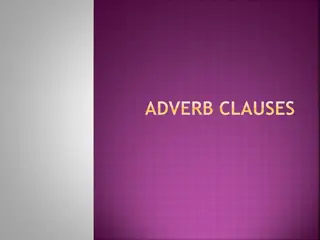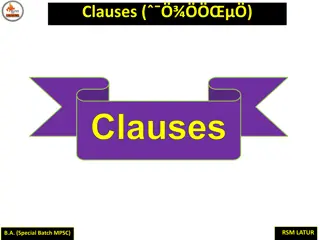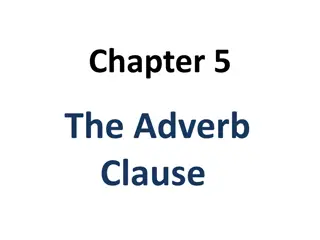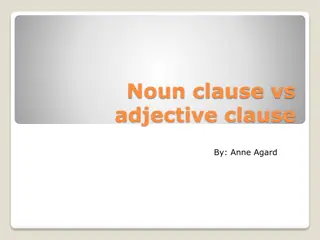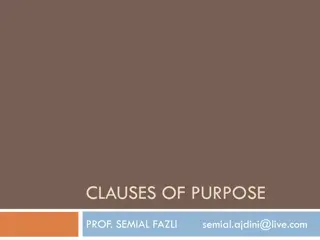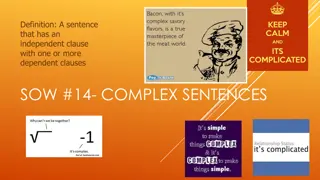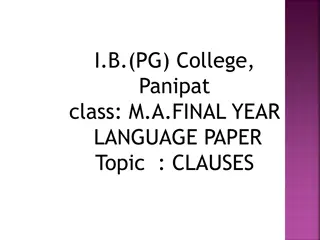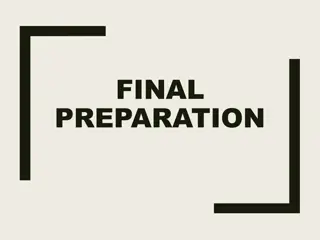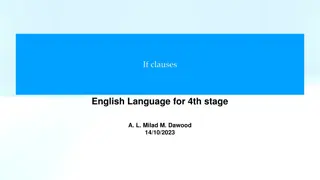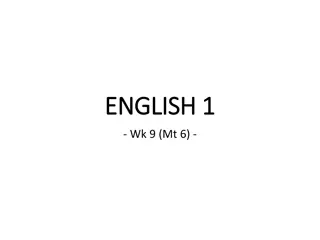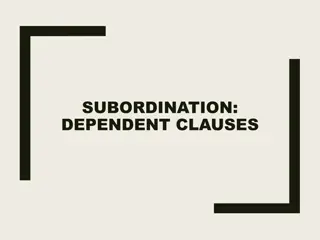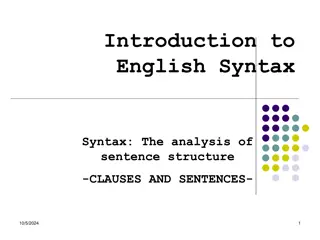Understanding Types of Clauses in English Grammar
A clause is a fundamental unit of a sentence, comprising a subject and predicate. Learning about the different types of clauses - Independent, Dependent, Relative, and Noun clauses - helps in enhancing grammar skills and sentence structure understanding. Independent clauses stand alone as complete sentences, while dependent clauses rely on the rest of the sentence for meaning. Relative clauses, introduced by relative pronouns, provide additional information about a noun. By grasping these concepts, one can construct more cohesive and effective sentences.
Download Presentation

Please find below an Image/Link to download the presentation.
The content on the website is provided AS IS for your information and personal use only. It may not be sold, licensed, or shared on other websites without obtaining consent from the author. Download presentation by click this link. If you encounter any issues during the download, it is possible that the publisher has removed the file from their server.
E N D
Presentation Transcript
TYPES OF CLAUSES IN ENGLISH GRAMMER
What is a clause? A clause is a part of a sentence. A clause is a group of words that has subject and predicate. Every complete sentence is made up of at least one or more clause(s). Following are clause examples:- John bought a new car. (One sentence, one clause) John bought a new car, but he is using his old car. (One sentence, two clauses)
Types of Clauses Every clause has at least a subject and a verb. Clauses have some characteristics that help to distinguish one type of clause from another. Clauses are of following types:- Independent Clauses (Main Clause) Dependent Clauses (Subordinate Clause) Relative Clauses (Adjective Clause) Noun Clauses
Independent Clauses (Main Clause) An independent (or main clause) is a complete sentence. It contains a subject and verb and expresses a complete thought in context and meaning. It expresses a complete thought. Independent clause structure: Subject + Verb = Complete Thought. For example: She walked. (This sentence contains only two words but it is still complete because it has subject and predicate) Main clauses can be joined by a coordinating conjunction to form complex or compound sentences. COORDINATING CONJUNCTIONS: and, but, for, nor, or, yet For example: He bought new car but he is still using old one. "but" is used to combine two independent clauses.
Dependent Clauses (Subordinate Clause) A dependent clause (or subordinate clause) is part of a sentence; it contains a subject and verb but does not convey complete sense. They can make sense on their own, but, they are dependent on the rest of the sentence for context and meaning. A dependent clause is joined to an independent clause to form a complex sentence. It often starts with a subordinating conjunction.
Dependent Clauses (Subordinate Clause) SUBORDINATING CONJUNCTIONS although even if provided that though unless where after before once since until whereas as even though rather than than whenever whether because if so that that when while Dependent clause structure: Subordinate Conjunction + Subject + Verb = Incomplete Thought. Examples: Whenever I go to superstore, I buy chips. .
Relative Clauses (Adjective Clause) A relative clause starts with the relative pronoun at the start of the clause like who, which, whose etc. To make distinction between an antecedent that is a human "who(m)" and an antecedent which is a non-human "which". Following will make it clear further. Who(m) is used when the antecedent is a person. That is used to refer to either a person or thing. Which is used to refer to anything except a person. (It is noteworthy that whom is not used much in spoken English.) Relative Clauses Examples I met my friends yesterday. The friend, who had curly hair, was very intelligent. The race was the one that I lost.
Relative Clauses (Adjective Clause) RESTRICTIVE RELATIVE CLAUSES AND NON-RESTRICTIVE RELATIVE CLAUSES Restrictive relative clauses are sometimes called defining relative clauses, or identifying relative clauses. Similarly, non-restrictive relative clauses are called non- defining or non-identifying relative clauses and is preceded by a pause in speech or a comma in writing. Restrictive Clause Example: The programmer who develops web applications will make a large profit. Non-Restrictive Clause Example: The programmer, who develops web applications, will make a large profit.
Relative Clauses (Adjective Clause) RESTRICTIVE RELATIVE CLAUSES AND NON-RESTRICTIVE RELATIVE CLAUSES Restrictive Non-restrictive Human which, that which, that which whose, of which Human Subject Object Nonhuman who, that who, whom, that whom whose, of whom Nonhuman who who, whom whom whose, of whom which which which After preposition Possessive whose, of which
Noun Clauses Noun Clauses: It is a dependent clause that works as noun. Noun clauses can act as subject, direct or indirect objects or predicate nominatives. Some examples are as under:- Tell me who left his book on the table. (direct object) I shall tell whoever will listen my interesting story. (indirect object) Whoever is the last one to leave turns off the lights. (subject) The boy with the curled hair is who I want on my team. (predicate nominative) Noun clauses often begin with pronouns or other words. That particular word usually has a grammatical function in the sentence
Noun Clauses Relative pronouns: that, what, who, which, whom, whose Indefinite relative pronouns: whoever, whomever, whatever, whichever, whether, if Interrogative adjective: what Interrogative adverb: how Interrogative pronoun: who Subordinating conjunctions: whenever, how, when, if, where, whether, why



